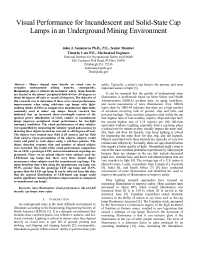Mining Publication: Visual Performance for Incandescent and Solid-State Cap Lamps in an Underground Mining Environment
Original creation date: September 2007
Miners depend most heavily on visual cues to recognize underground mining hazards; consequently, illumination plays a critical role in miners' safety. Some hazards are located in the miners' peripheral field-of-view (10 degrees to about 60 degrees off-axis) or on-axis (0 degrees). The objective of this research was to determine if there were visual performance improvements when using solid-state cap lamps with light emitting diodes (LEDs) as compared to incandescent light bulbs commonly used in miner cap lamps. Recent research has indicated that an increased short-wavelength content of the spectral power distribution of LEDs relative to incandescent lamps improves peripheral visual performance for low-light (mesopic) conditions. The visual performances of nine subjects were quantified by measuring the subjects' speed and accuracy in detecting floor objects located on axis and at ±20 degrees off axis. The objects were located near field (1.83 meters) and far field (3.66 meters). Upon presentation of the objects, subjects would count and point to each object using a red-laser pointer. The object detection response time and number of missed objects were recorded. The results of the visual performance comparison for an LED, a prototype LED, and an incandescent cap lamp are presented. There we no missed objects when subjects used the LED-based cap lamps but, there were three missed object occurrences when subjects used the incandescent cap lamp. The mean detection time when using the incandescent cap lamp was 55.3% greater than the prototype LED cap lamp and 43.5% greater than the LED cap lamp. It can be inferred from this data that the spectral distribution of LED-based cap lamps could enable significant visual performance improvements as compared to incandescent cap lamps.
Authors: JJ Sammarco, TJ Lutz
Conference Paper - September 2007
NIOSHTIC2 Number: 20032704
IAS '07: Conference Record of the 2007 IEEE Industry Applications Conference: Forty-second IAS Annual Meeting, September 23-27, 2007, New Orleans, Louisiana. Piscataway, NJ: Institute of Electrical and Electronics Engineers, 2007; 4:1-6
See Also
- Assessing and Monitoring Open Pit Mine Highwalls
- Continuous Mining: A Pilot Study of the Role of Visual Attention Locations and Work Position in Underground Coal Mines
- Discomfort Glare Comparison for Various LED Cap Lamps
- The Effect of Cap Lamp Lighting on Postural Control and Stability
- Evaluation of Peripheral Visual Performance When Using Incandescent and LED Miner Cap Lamps
- Experiments on Personal Equipment for Low Seam Coal Miners: IV. Incorporating Coiled Cord Into Cap Lamp Battery Cords
- Technological Aspects of Solid-State and Incandescent Sources for Miner Cap Lamps
- Technological Aspects of Solid-State and Incandescent Sources for Miner Cap Lamps
- Toolbox Training For Construction Aggregate Miners
- Visual Performance for Incandescent and Solid-State Cap Lamps in an Underground Mining Environment
- Page last reviewed: 9/21/2012
- Page last updated: 9/21/2012
- Content source: National Institute for Occupational Safety and Health, Mining Program


 ShareCompartir
ShareCompartir
